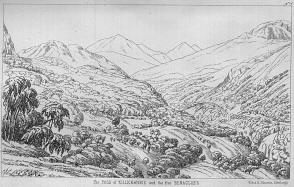|

THE Highlanders of Scotland are unquestionably a most interesting race
people, the true descendants of the ancient Caledonians; and though their
early history has been greatly obscured by some pretended historians, and
continues to be so even to this day, whereby readers are misled, yet the
true narration of ancient facts respecting them, is independent of all the
vain prejudice of those who would represent them, and their language, to be
merely derived from the insignificant colony of Irish Scots which came into
Argyleshire in the sixth century, where still remain their descendants,
properly the only Scots in Scotland. With this in view, the writer submits
the present small ‘work, which is not written with a desire merely to
contradict others, but to point out and establish the truth, without any
intention to depreciate previous writers. This he has endeavoured to do in a
charitable spirit, when obliged to notice manifest errors (and for this the
writer has always given the, proofs and reasons), or when forced, in
maintaining the liberty of opinion, to express decided opposite views to
some who have not founded their assertions on proper evidence. The necessary
researches on the ancient historical points herein treated of were commenced
four years ago, and have been continued ever since, and originally were
intended as a continuation of a small work the author wrote on the ancient
Earldom of Atholl, which embraces the whole North Highlands of Perthshire.
The investigations have led to the present volume, which has no pretensions
to anything but a desire to place the true early history of the origin,
etc., etc., of his countrymen, the Highlanders of Scotland, on an
undeniable trustworthy foundation, supported by proofs and authorities, and
to refute the unfounded claims of some grasping Irish writers, as also the
false assertions of some Scottish ones.
Much pains has been taken to make the proofs concise upon the subjects
brought forward, at the same time, to be sufficiently comprehensive. A
careful perusal will best enable the reader to judge on this point; and the
explanatory notes being read along with the text is essential to the full
understanding of what is wished to be known. There has been no attempt made
otherwise than to convey to the reader as much strictly accurate,
historical, and antiquarian information as possible, and thereby lead to
the true understanding of the early history of the descendants of the noble
race of the Caledonian Gael. Upon the subject of their language, it is hoped
that some of the Highland clergymen, or others, may follow that subject in a
similar manner, as the writer has endeavoured to do.
The descriptions of the illustrations of the country of the Gael of Alban
will be found in a chapter together, though they are themselves placed in
different parts of the work. This collection of proofs from the earliest
times may, it is also hoped, prove useful to future writers who wish to go
into greater detail, and. That some interest may be felt in the Pictish
Gael, who have been by many hitherto looked upon as quite an unknown people,
and as the ‘Rev. Isaac Taylor says, ‘disappear mysteriously,’ as also the
supposed destruction of their language, the greatest marvel of its kind that
ever passed for truth.
The writer had not, the opportunity to notice, in the proper place (on the
dress of the Caledonian Gael, the embellishment that appears on the
binding. It is the most faithful representation of the ancient Highlanders’
dress that can be given to the reader. It is derived from two different
sculptured stones, namely, from that of Dull, Perthshire, which is
described page 232, and it is a facsimile of the countenance, bonnet, and
shield of one of the figures thereon. The arrangement of the
‘Breacan—an—fheilidh,’ that is, ‘the belted plaid,’ or full dress of’ the
ancient Gael or Highlanders, is a faithful copy from another ancient
sculptured stone found at St Andrews. Both these sculptures are to be seen
in the Museum of the Antiquaries of Scotland, Edinburgh, open to the public,
and wherewith the embel1ishment can be compared. The Map also, it is hoped,
along with a most copious index, and very full table of contents, may prove
useful to the reader.
The writer also expects hereafter to be enabled to bring out a short
Supplement to this small work, containing further ancient historical and
antiquarian information, interesting not only to the Highlanders, but also
to all Scotchmen.
118 PRINCES STREET, EDINBURGH,
5th July 1865 |

